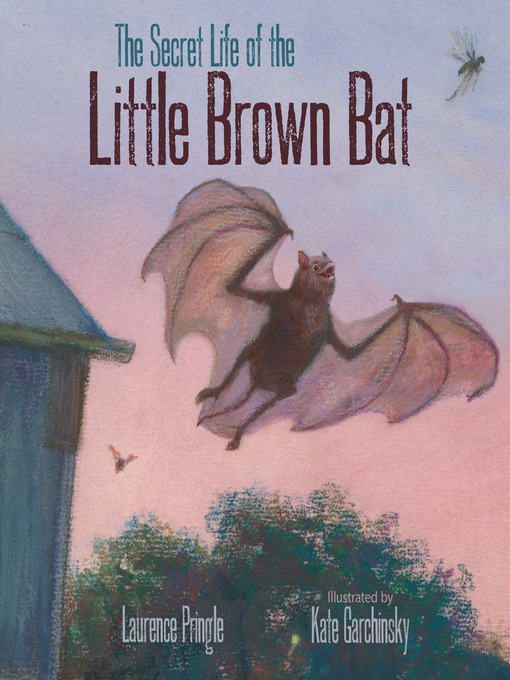This gorgeous and lyrical picture book follows a year in the life of a little brown bat named Otis as he learns to be a hunter, escape predators, and find a mate. Stunning, realistic illustrations celebrate the beauty of these mysterious creatures as readers learn important facts through an engaging and fascinating story. The book also includes back matter with more in-depth information, a glossary, and further resources.
-
Creators
-
Publisher
-
Release date
November 3, 2020 -
Formats
-
Kindle Book
-
OverDrive Read
- ISBN: 9781635924992
-
-
Languages
- English
-
Levels
- ATOS Level: 4.1
- Lexile® Measure: 630
- Interest Level: K-3(LG)
- Text Difficulty: 2-3
-
Reviews
-
School Library Journal
Starred review from August 1, 2018
Gr 2-5-Otis is a little brown bat living a mysterious life. Pringle reveals with captivating detail this amazing creature's growth, from his early beginnings learning to hunt and fly solo to capturing prey using ultrasonic sounds. This book is a delightful work of narrative nonfiction that communicates facts and terminology about brown bats alongside beautiful artwork. Done in pastels and aqua crayons on sanded paper, the illustrations are an enchanting addition to the text. From the night scenes to the sun slowly dawning, Garchinsky expertly captures various scenes of bat life, such as Otis capturing a moth for dinner. While the overall story is written in an accessible way for younger readers, Pringle also includes a solid amount of information in the back matter, including an explanation of the name Otis (the species' scientific name is Myotis lucifugus) and a call to action about the white nose disease that is threatening brown bat populations. VERDICT An excellent choice for elementary nonfiction collections.-Molly Dettmann, Norman North High School, OK
Copyright 2018 School Library Journal, LLC Used with permission.
-
Kirkus
July 15, 2018
The activities of a young brown bat over his first summer on his own serve as introduction to the most widespread bat species in the U.S.Pringle weaves information about the lives of these misunderstood mammals into his imagined-from-facts tale of "Otis," named for his species, Myotis lucifugus. As always, this veteran science writer mostly avoids anthropomorphization, describing actions with lively language that's fun to read aloud: "Otis zigs and zags, flutters and dives, hovers and swoops, dips and swerves....He is finding, chasing, catching, and eating insects." To begin, there's a flashback to the bat's puphood, nursing from his mother. The story proceeds with a night of hunting and a detailed explanation of how Otis catches insects in flight. He meets prey whose ability to hear ultrasound clicks helps them escape and a predator, an owl, that he avoids. After the summer feeding, Otis flies far to join others in a cave, mate (mentioned, not described), and hibernate until spring. The conclusion of this simple story demonstrates the importance of these bats to our lives: When they return in the spring, "Lots of mosquitoes and other insects will be in big trouble!" Appropriate vocabulary introduces relevant concepts. The species-threatening white-nose syndrome is described in an afterword for adult readers. Garchinsky's darkly atmospheric illustrations, created with pastels and aqua crayons on textured paper, will show well at storytime.A simple but effective appreciation. (author's note, glossary) (Informational picture book. 3-7)COPYRIGHT(2018) Kirkus Reviews, ALL RIGHTS RESERVED.
-
Booklist
Starred review from September 15, 2018
Grades K-3 *Starred Review* At sunset, a bat called Otis awakens. Hanging upside down from a barn beam beside other little brown bats, he grooms himself. The text describes his physical features and his experiences as a pup, nurtured and trained for independence by his mother. Next, Otis flutters out into the twilight on his own. He swoops down to gulp water from a nearby pond and then flies over a meadow. Using echolocation, he finds, catches, and eats a variety of insects before heading back to his roost. Pringle, who received the AAAS Lifetime Achievement Award in Children's Science Writing, also wrote Batman: Exploring the World of Bats (1991) and Bats! Strange and Wonderful (2000). Introducing bats to a somewhat younger audience, his new text offers a lively, engaging account of one animal's life, including specific details, such as how bats feed during flight, snagging insects with a wing and flipping them into position for eating. The back matter offers further information, including a section on white-nose syndrome, which has killed millions of bats in the last decade. Created with pastels and water-soluble crayons, the impressionistic illustrations use soft strokes of color to portray the bat and his world. A beautiful, informative picture book about this common North American bat.(Reprinted with permission of Booklist, copyright 2018, American Library Association.) -
The Horn Book
January 1, 2019
Otis, a newly weaned bat, takes his first flights to search for food. In preparation, he carefully grooms his wings. During flight, he uses echolocation to find insects. Over the course of one summer, he avoids predators and finds a mate. Scientific details about these concepts are integrated into the narrative and are reflected in shadowy, textured illustrations that capture the movements of the expressive young bat. Glos.(Copyright 2019 by The Horn Book, Incorporated, Boston. All rights reserved.)
-
Languages
- English
Levels
- ATOS Level:4.1
- Lexile® Measure:630
- Interest Level:K-3(LG)
- Text Difficulty:2-3
Loading
Why is availability limited?
×Availability can change throughout the month based on the library's budget. You can still place a hold on the title, and your hold will be automatically filled as soon as the title is available again.
The Kindle Book format for this title is not supported on:
×- - Kindle 1
- - Kindle 2
- - Kindle DX
- - Kindle Keyboard
- - Kindle 4
- - Kindle Touch
- - Kindle 5
- - Kindle Paperwhite
- - Kindle 7
- - Kindle Voyage
Read-along ebook
×The OverDrive Read format of this ebook has professional narration that plays while you read in your browser. Learn more here.




